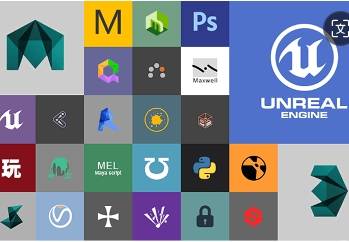Release date:2022, August 10
Duration:10 h 52 m
Author:Kamel Khezri
Skill level:Beginner
Language:English
Exercise files:Yes
I’m very glad to bring you our new online course: “The Ultimate Introduction to Redshift For Cinema 4d”. It’s 952 minutes, more than 16 hours of on-demand videos in 86 lessons, covering everything about Redshift for Cinema 4d, including lighting, shading, Cameras, rendering, etc.
We’ve been working on this course for the past 100 days and it feels amazing to finally be able to make it available to you. Every single minute of every single video is planned and thought for, you get the top-notch quality you’ve come to expect from MographPlus. We’ll keep the course updated at least for a year after the initial launch, even though we tend to keep our course updated for much longer.
Now let’s talk about the course itself,
Chapter 1: Introduction (29 min)We start off the course by introducing Redshift for Cinema 4d, where to find different Redshift tools and functions, and walk you through the general workflow to get your job done with Redshift.
Chapter 2: Lighting (102 min)The next section of the course is all about lighting, you learn about the fundamentals of lighting and different lighting techniques while learning about the vast and unique lighting tools that Redshift offers.
We learn about Area Lights, Mesh, spot, infinite and IES lights, Dome Light and Image-based lighting.
We talk about Redshift Sun and Sky, you learn how to approach interior and exterior lighting in Redshift for Cinema 4d.
We learn about the amazing volumetric effects in Redshift with Redshift Environment Object.
I explain how to use Redshift to integrate 3d geometries onto HDR environments or photographic backplates… and much more…
In section 3, we talk about Global illumination or indirect lighting, first we learn how light rays work in real world and how Redshift simulates the same behavior using GI, then we start learning about different GI engines in Redshift, like Brute Force, Irradiance Point Cloud and Irradiance Cache We learn how to use these engines in different lighting scenarios to produce the most realistic lighting possible, the pros and cons of each one and where to use them. And finally explain how to render flicker-free object animations with GI.
In the next section of the Ultimate Introduction to Redshift for Cinema 4d, we start discussing Redshift Materials, shaders and nodes. Not only you learn about all the specific Redshift Materials, but after watching this section, you will be equipped with the core shading fundamentals and cutting-edge techniques in shader development. First, we learn about the powerful Redshift Material which is capable of creating all sorts of materials, we dedicated 9 in-depth videos to this shader.
Then we discover bump, normal, tessellation and displacement mapping in Redshift. After that I will introduce you to a new simplified approach to shader creation, I will show you how to create some of the most daily shaders like plastic, wood, concrete, metals.
You also learn how to create highly realistic human skin shader using the Redshift Material.
Principled hair shader will be covered in detail, it’s an easy to use, yet powerful shader.
We’ll be covering the robust CarPaint material as well. We learn how to read and render Mograph and field colors and render them with Redshift. Then we learn about Material Blender, Color Layer, Mix and Composite nodes. Ray Switch, Shader Switch, Triplanar, Ambient Occlusion, Curvature and Sprite shaders will be discussed in detail. We also learn about OSL shader, substance support, math, conversion nodes and much more. Hopefully after watching this section, you should be very comfortable developing complex shaders in Redshift.
Then we learn all about Cameras, camera types, Depth of field, motion blur and everything that relates to working with cameras in Redshift. First we learn about the fundamentals of working with Cameras and photographic exposure settings in Redshift, then we learn how to get Depth of field and motion blur, we learn about different camera types and VR Ready renders in Redshift, we also talk about lens effects, color correction and Lookup tables.
Section six of the course is all about rendering with Redshift, we learn all about the fundamentals of image sampling and ray tracing in Redshift, first we explore how to use the Basic mode of the Redshift Render settings, then we discuss automatic and unified sampling in depth, then I show you how to setup unified sampling practically for a few different scenes to reinforce all the theories we’ve learned previously, after that we learn about the differences between bucket and progressive rendering. Then we take a close look at Redshift RT, which is Redshift’s near Realtime interactive render engine.
Then we talk about ACES, a system to manage color in all levels of the production, I will give you an overall understanding of what ACES is and does, how to set it up properly in Redshift, which is really simple as it is the default color management solution in Redshift. Then I share a few examples comparing ACES and the older color manger and show you why ACES is just way better, and finally how to deal with ACES-managed renders in post.
Then we take an in depth look at Render View and learn about all of its features.
We also cover both Optix and Altus denoisers in-depth with a lot of comparative examples. After that, we dive deep into the subject of AOVs. What are the AOVs that Redshift offers and how to save them out. we talk about custom AOVs, cryptomatte workflow, light group AOVs, and finally compositing AOVs in fusion will be covered, both the famous back to beauty composite with the essential AOVs and the light mix composite for relighting purposes in post.
We also learn how to deal with caustics in Redshift, The rest of the render settings will be explained as well in a few videos.
Chapter 7: Miscellaneous (77 min)In the next section, we take a closer look at a few miscellaneous topics, like Redshift proxy, object tag, dealing with particles and splines and much more. We also learn about Redshift Volume, I show you all the steps you need to render openVDB files in Redshift and how to render amazing and realistic clouds, fire, smoke and explosions using Redshift.
This chapter covers all the new features introduced in Redshift 3.5. This update is heavily focused on the new redshift standard surface material, we learn all about this amazing new shader which is capable of creating all sorts of materials in 9 in-depth videos. In the first release of the course, we had a lesson in the shading section called how to basic shaders, where I show you how to create some of the fundamental shaders like plastic, wood, concrete and metals using redshift material, this update includes a video where I show you how to create the same shaders using the new standard surface material. And finally, we learn about the new CPU and Hybrid rendering introduced in Redshift 3.5
Chapter 9: What’s new in Redshift 3.5.02 to 3.5.06 (10 min)This chapter covers all the new features added in Redshift 3.5.02 to 3.5.06 There are 2 new videos covering the new Random Walk SSS mode in the redshift standard material and the new blackbody emission mode in the Redshift Volume Material.
If you want to learn Redshift For Cinema 4d, this is the course to get, period. we work really hard on our courses to assure the quality of them, and you get an academically-orientated, well-structured course that will take you to the next level of your career as an artist.
01. Introduction 02. User Interface 03. General Workflow 04. Setting Up ACES
02. Lighting05. Area Light 06. Area Light – Other Shapes 07. Mesh Light 08. Spot Light 09. IES Light 10. Infinite Light 11. Dome Light 12. Sun and Sky 13. Interior Lighting 14. Redshift Environment 15. Shadow Matte, Adding 3D Objects to Photos
03. Global Illumination16. What is GI 17. Brute Force 18. Irradiance Point Cloud 19. Irradiance Cache 20. GI and Animation
04. Shading21. Redshift Material – Diffuse 22. Redshift Material – Translucency 23. Redshift Material – Reflection 24. Redshift Material – Refraction 25. Diffuse Material, Refraction Subsurface 26. Redshift Material – Sheen 27. Redshift Material – Multi-SSS 28. Redshift Material – Coating 29. Redshift Material – Overall 30. Bump Mapping, Normal Mapping, Bump Blender, and Round Corners 31. Tessellation, Displacement Mapping and Displacement Blender 32. Material Blender, Color Layer, Mix and Composite 33. How to Basic Shader 34. How to Human Skin 35. Principled Hair 36. Car Paint 37. Ray Switch, Shader Switch 38. Triplanar 39. AO and Curvature 40. User Data Nodes 41. User Data Nodes – Reading Mograph and Field Colors 42. Sprite Node 43. Other Nodes 44. Substance Support
05. Camera45. Basics of Redshift Camera 46. Understanding Photographic Exposure 47. Depth of Field 48. Motion Blur 49. Camera Types 50. Color Controls and LUT 51. Lens Effects
06. Rendering52. Basic Render Settings 53. Sampling Explained 54. Automatic Sampling 55. Unified Sampling 56. Unified Sampling – Practical Examples 57. Bucket and Progressive Rendering 58. Redshift RT 59. ACES 60. Render View 61. Denoising 62. AOVs 63. Custom AOVs 64. Light Group AOVs 65. Compositing AOVs in Fusion 66. Caustics 67. Sample Filtering 68. Other Settings
07. Miscellaneous69. Redshift Volume 70. Object Tag 71. Proxy 72. Particles and Splines 73. Tools
08. New in Redshift 3.5 (Update 1)74. Standard Surface – Base 75. Standard Surface – Reflection 76. Standard Surface – Transmission 77. Standard Surface – Subsurface 78. Standard Surface – Coat 79. Standard Surface – Sheen (Fabrics) 80. Standard Surface – Thin Film 81. Standard Surface – Emission 82. Standard Surface – Geometry 83. Standard Surface – How to Basic Shaders 84. Standard Surface – CPU and Hybrid Rendering
09. New in Redshift 3.5.02 to 3.5.06 (Update 2)85. Randomwalk SSS 86. Blackbody Emission
[Gumroad] The Ultimate Introduction to Redshift 3 and 3.5 For Cinema 4D (Aug 10, 2022) by MographPlus.7z.001 [Gumroad] The Ultimate Introduction to Redshift 3 and 3.5 For Cinema 4D (Aug 10, 2022) by MographPlus.7z.002 [Gumroad] The Ultimate Introduction to Redshift 3 and 3.5 For Cinema 4D (Aug 10, 2022) by MographPlus_Subtitles.7z
 Channel and
Channel and  Group
Group
1、登录后,打赏30元成为VIP会员,全站资源免费获取!
2、资源默认为百度网盘链接,请用浏览器打开输入提取码不要有多余空格,如无法获取 请联系微信 yunqiaonet 补发。
3、分卷压缩包资源 需全部下载后解压第一个压缩包即可,下载过程不要强制中断 建议用winrar解压或360解压缩软件解压!
4、云桥网络平台所发布资源仅供用户自学自用,用户需以学习为目的,按需下载,严禁批量采集搬运共享资源等行为,望知悉!!!
5、云桥网络-CG数字艺术学习与资源分享平台,感谢您的赞赏与支持!平台所收取打赏费用仅作为平台服务器租赁及人员维护资金 费用不为素材本身费用,望理解知悉!



评论(0)